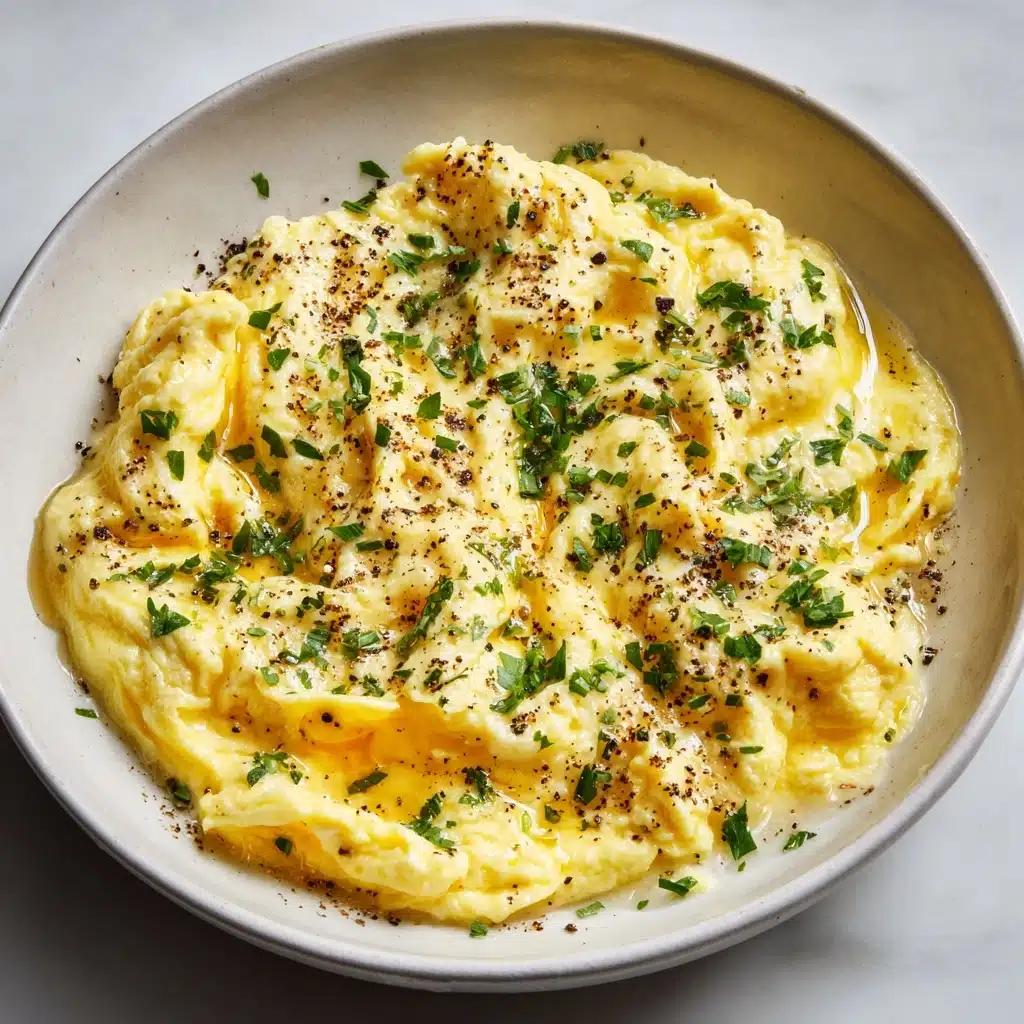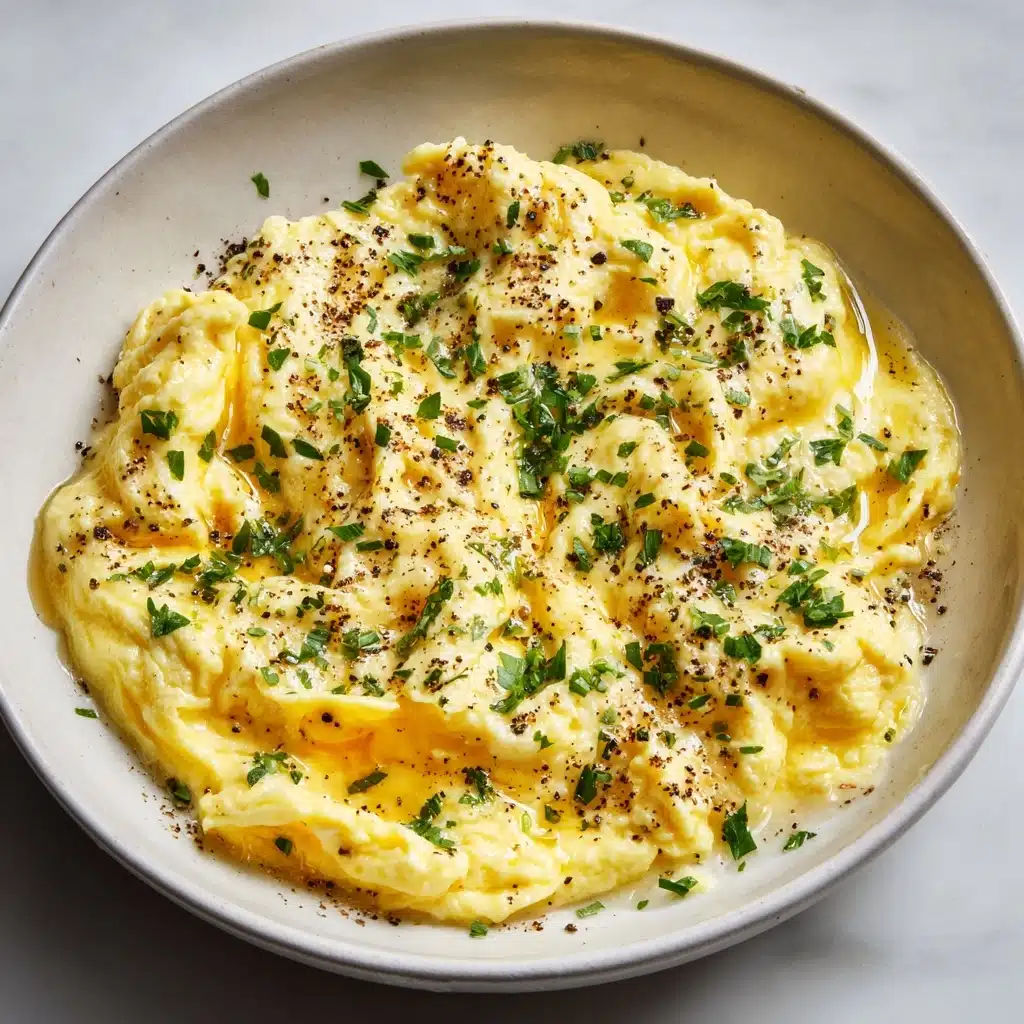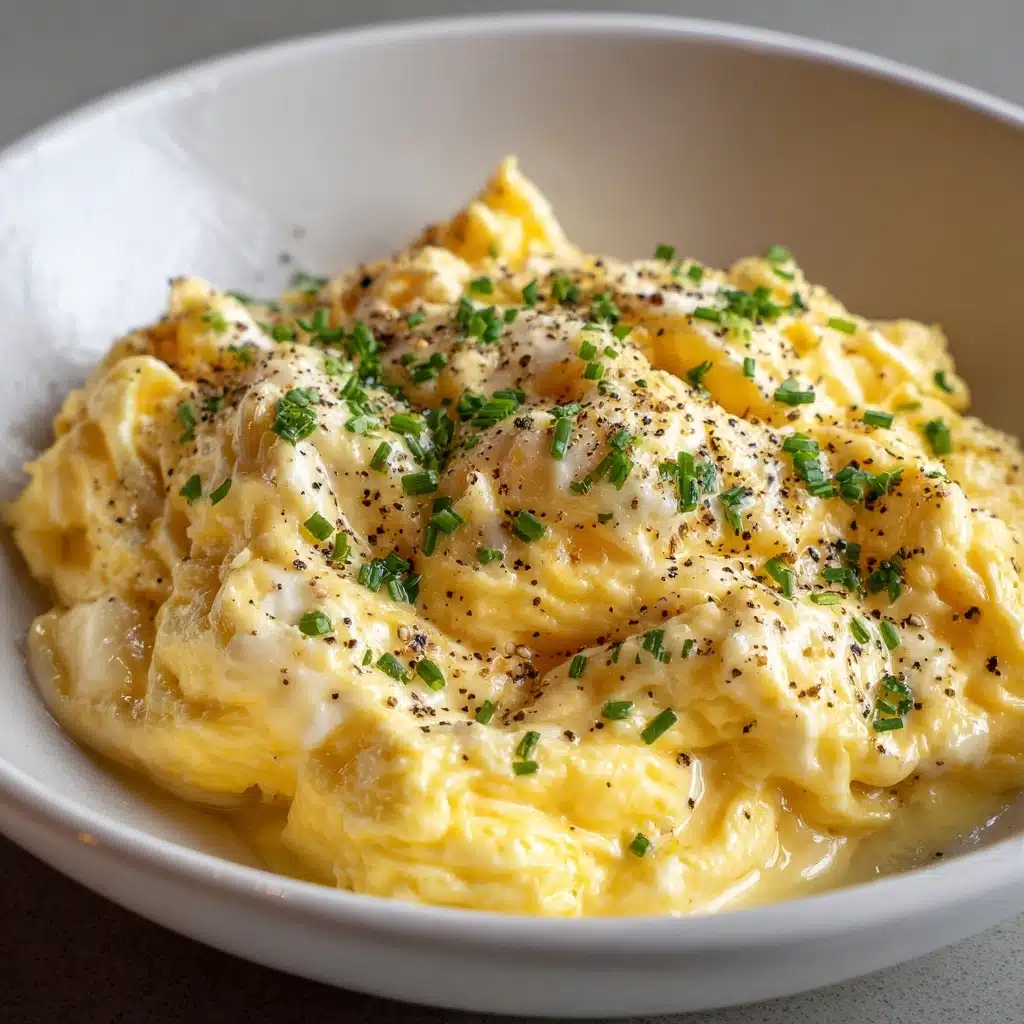Welcome to a world of silky, melt-in-your-mouth eggs: French-Style Scrambled Eggs. Forget rubbery, rushed breakfasts—this dish transforms the humble egg into something wholly luxurious, thanks to a little patience and lots of butter. Cooking these eggs slowly over gentle heat coaxes out a custardy, cloud-like texture that feels indulgent for any occasion. With just a handful of simple ingredients and a low, slow approach, you’ll soon be savoring eggs the way chic Parisian bistros intend: rich, creamy, and impossibly soft.
Ingredients You’ll Need
The magic of French-Style Scrambled Eggs is in their simplicity. Every ingredient brings its own personality to the party, so use the best you can find—these eggs deserve it! Here’s what you’ll need, with a tip for each:
- 4 large eggs: Use the freshest eggs possible for a bright flavor and lush, golden curds.
- 2 tablespoons unsalted butter: Butter is the heart of this recipe, adding richness and ensuring that creamy, signature texture.
- 1 tablespoon heavy cream or crème fraîche (optional): A dash swirled in at the end makes the eggs even silkier and more luxe.
- Salt and white pepper to taste: Season simply; white pepper adds a gentle heat without marring the golden hue.
- Chopped fresh chives (for garnish): These add a pop of color and a delicate, oniony freshness that perfectly lifts the rich eggs.
How to Make French-Style Scrambled Eggs
Step 1: Prepare the Eggs
Crack the eggs into a cold, clean saucepan (ideally nonstick), and whisk thoroughly. You’re looking for a completely smooth mixture—no visible streaks of yolk or white. Starting in a cold pan is key; it keeps the proteins from seizing up, which is what helps create that custardy French-Style Scrambled Eggs texture.
Step 2: Add the Butter and Begin Cooking
Place your saucepan over the lowest heat you can manage. Add the butter directly to the eggs. Using a rubber spatula, gently and continuously stir the mix, making slow, lazy figure-eights and scraping the sides as you go. This constant movement and low temperature are the secrets to those luscious, tiny, tender curds.
Step 3: Keep It Low and Slow
Patience is your friend here. After about 8–10 minutes, the eggs will begin to thicken, looking almost like a rich custard. Resist any urge to turn up the heat—rushing risks making the eggs rubbery or dry instead of that velvety French-Style Scrambled Eggs perfection.
Step 4: Finish with Cream and Season
As soon as the eggs reach your preferred consistency (soft and glossy is the classic), remove the pan from the heat. If you like, stir in the heavy cream or crème fraîche now; this cools the eggs slightly and adds an extra layer of silkiness. Finish with a generous pinch of salt and a touch of white pepper, tasting and adjusting as needed.
Step 5: Garnish and Serve
Spoon your lovely eggs onto warm plates and sprinkle with a snowfall of chopped fresh chives. Serving right away is non-negotiable—French-Style Scrambled Eggs wait for no one! The heat of the eggs will gently wilt the chives and perfume each bite.
How to Serve French-Style Scrambled Eggs

Garnishes
A generous handful of freshly chopped chives adds just the right hint of sweetness and a burst of green to your French-Style Scrambled Eggs. For something a little extra, try microgreens, a twist of cracked black pepper, or even a dusting of grated Parmesan. Each finishing touch highlights how special—yet effortless—this dish truly is.
Side Dishes
French-Style Scrambled Eggs are practically made for a buttered piece of toasted brioche or a flaky croissant, which both provide the perfect vehicle for scooping up the rich, creamy eggs. For a lighter plate, pair with a crisp salad of baby greens, or serve with ripe, sliced tomatoes drizzled with a splash of good olive oil.
Creative Ways to Present
Transform your eggs into an elegant brunch centerpiece by spooning them onto sourdough toast with smoked salmon and a sprinkle of dill. For something whimsical, fill mini puff pastry cases with the eggs and top with caviar or sautéed mushrooms. French-Style Scrambled Eggs are a blank canvas for breakfast artistry—let your creativity shine!
Make Ahead and Storage
Storing Leftovers
If you find yourself with extra French-Style Scrambled Eggs, let them cool, then transfer to an airtight container and refrigerate. For best texture and flavor, enjoy within a day; the eggs will lose a bit of their custardy magic over time, but they’ll still make a quick, tasty snack or base for a breakfast sandwich.
Freezing
Freezing French-Style Scrambled Eggs isn’t ideal—the delicate texture doesn’t hold up well to ice and thawing. If you must, portion them into small containers and wrap tightly. Reheat straight from frozen, but expect a softer, looser result that’s better suited for mixing into other dishes like fried rice or casseroles.
Reheating
To gently rewarm leftovers, cook them over a very low heat in a saucepan, stirring constantly and adding a splash of cream or milk if needed. The goal is to bring the eggs back to their creamy best without scrambling them further or drying them out. A microwave on low power works in a pinch, but keep a close eye—it’s easy to overcook them.
FAQs
Can I use milk instead of cream or crème fraîche in French-Style Scrambled Eggs?
Absolutely! While cream or crème fraîche lend extra richness and silkiness, whole milk is a good substitute if you’re looking for a lighter texture. Just add it at the very end to prevent curdling.
Why do I need to cook the eggs over such low heat?
Low heat is crucial for forming those tiny, delicate curds that define French-Style Scrambled Eggs. Higher heat will cook the eggs too quickly, causing them to get dry and lumpy instead of luxuriously creamy.
Can I add cheese or other mix-ins?
Of course! Try gently folding in a small handful of grated Gruyère or crumbled goat cheese right at the end. For extra flair, sautéed mushrooms, spinach, or even a dollop of pesto make delicious additions, just keep the quantities modest so the eggs remain the star.
How do French-Style Scrambled Eggs differ from American-style scrambled eggs?
French-Style Scrambled Eggs are stirred constantly over low heat, resulting in a custardy, silky-smooth texture. American-style scrambled eggs are usually cooked more quickly over higher heat, producing larger, firmer curds that are drier and fluffier by comparison.
What is the best pan to use for making French-Style Scrambled Eggs?
A small, heavy-bottomed nonstick saucepan is ideal, as it allows for gentle, even heating and makes it easy to stir constantly without sticking. Avoid cast iron or stainless steel unless they’re well seasoned and you’re confident in your stirring game!
Final Thoughts
There’s nothing quite as comforting—or as impressive—as a plate of perfectly made French-Style Scrambled Eggs. Once you’ve tried this technique, you’ll understand why it’s a staple of French cafés and gourmet kitchens alike. Don’t be surprised if these become your favorite breakfast treat—give it a go and experience the magic in every creamy bite!
PrintFrench-Style Scrambled Eggs Recipe
Elevate your breakfast game with these luxurious French-style scrambled eggs. Delicately creamy and perfectly seasoned, these eggs are a gourmet treat that will make your mornings extra special.
- Prep Time: 5 minutes
- Cook Time: 10 minutes
- Total Time: 15 minutes
- Yield: 2 servings
- Category: Breakfast
- Method: Stovetop
- Cuisine: French
- Diet: Vegetarian, Gluten-Free
Ingredients
Eggs:
4 large eggs
Butter:
2 tablespoons unsalted butter
Heavy Cream or Crème Fraîche:
1 tablespoon (optional)
Salt and White Pepper:
to taste
Chopped Fresh Chives:
for garnish
Instructions
- Whisk Eggs: Crack the eggs into a cold saucepan and whisk thoroughly until smooth.
- Cook Eggs: Place the pan over very low heat, add butter, and stir constantly until the eggs thicken, about 8-10 minutes.
- Finish Eggs: Remove from heat, stir in cream if using, season with salt and pepper, garnish with chives, and serve immediately.
Notes
- French-style scrambled eggs are best cooked slowly over low heat for a creamy texture.
- For a richer flavor, finish with a pat of butter instead of cream.
- Serve with toasted brioche or a buttery croissant for a delightful meal.
Nutrition
- Serving Size: 2 eggs
- Calories: 220
- Sugar: 1 g
- Sodium: 180 mg
- Fat: 19 g
- Saturated Fat: 10 g
- Unsaturated Fat: 8 g
- Trans Fat: 0 g
- Carbohydrates: 1 g
- Fiber: 0 g
- Protein: 11 g
- Cholesterol: 375 mg




